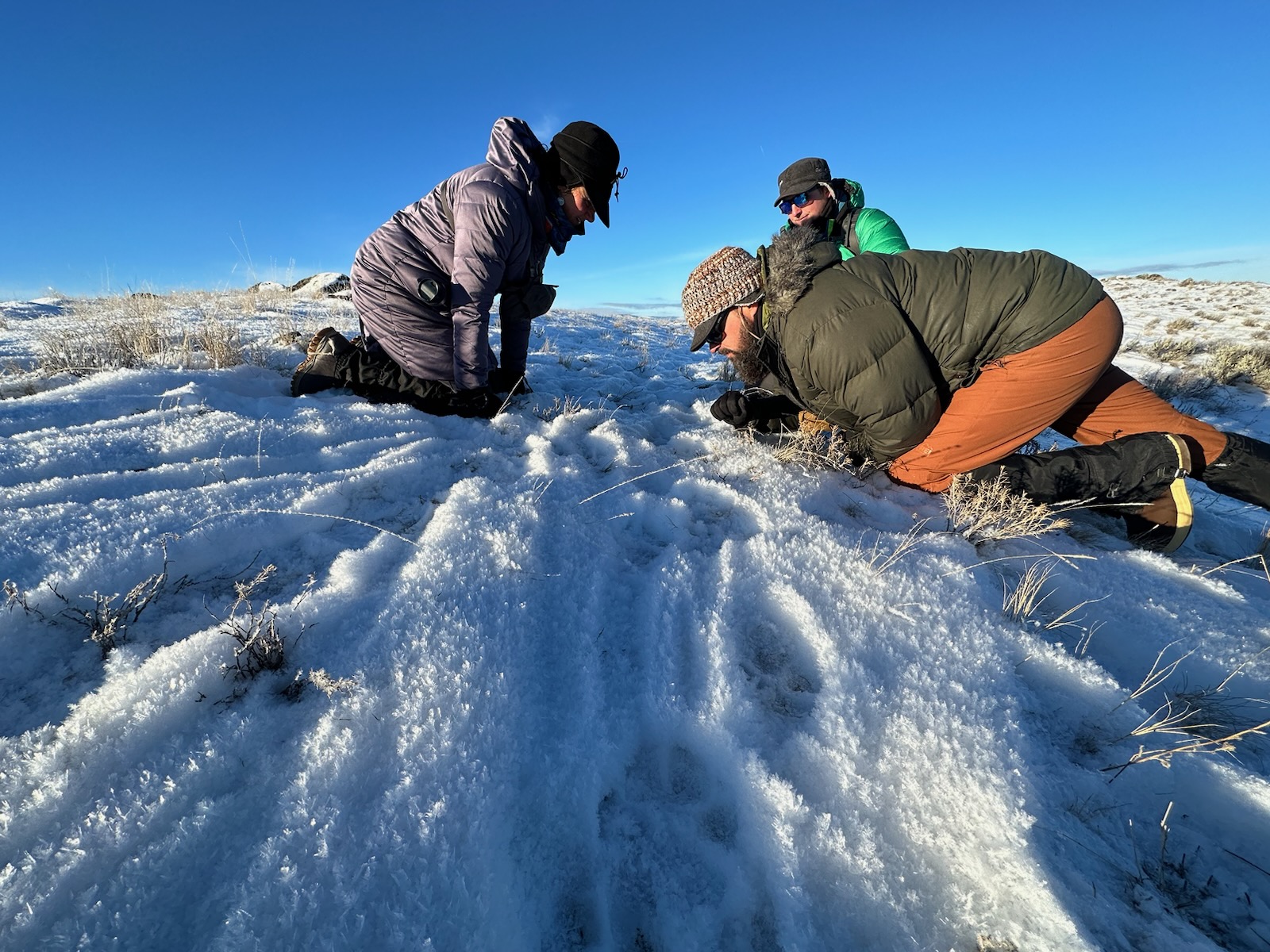Stories in the Snowpack – Winter Training 2023-24


Yellowstone Wild guides work to understand the tracks left by a pack of wolves. Photo by Emil McCain
Navigating snow, sagebrush, and downed timber, Yellowstone Wild Owner Emil McCain and 2023-24 winter guides came across telltale prints in the mid-December snowpack: wolves!
The tracks merged, converged, showed signs of trotting and loping, and at times crisscrossed downed trees playfully. Finally, at a clearing boasting a spacious view of Yellowstone National Park’s Northern Range, the tracks came together in a mishmash of pawprints messily overlapping one another. What happened here?
Laura, one of the Yellowstone Wild guides present during this tracking training, agreed with the group’s conclusion several wolves gathered at that location and likely engaged in a howling session. “Looking out over the landscape it was easy to see that— ‘Yes- that’s what happened right here!’ —and we were able to see what it was like for a wolf to look out over that same landscape we were seeing, just through a different lens,” Laura recalled.
Rather than contemplating the wide-open, sweeping vista—or perhaps in addition to that contemplation—the wolves likely considered where to find food, water, shelter, safety, and a suitable location to raise future generations of pups.
This narrative in the snow was one of many stories uncovered during winter training as the company prepared to greet guests from all over the world and provide them with the best possible winter visitation experience.
This particular winter, the guides and managers at Yellowstone Wild counted a combined 95 seasons (or nearly 48 years) of time spent in the field helping engage the curiosity of visitors to the world’s first national park. That’s not including countless hours spent researching, exploring, and recreating in Yellowstone during their “off time.” What made this training a little different? It focused less on factual tidbits and more on the various stories to be found by guests visiting Yellowstone.
The Stories of Individual Wolves and Packs
Inspiring, curious, and oftentimes heartbreaking, the lives of wolves as witnessed by guides and researchers in Yellowstone over the years have impacted many of those who have taken the time to learn about and document them. From the wolves killed in the late 1800s and early 1900s by poachers, trappers, and rangers, to the wolves driven through Roosevelt Arch at the North Entrance to Yellowstone in 1995 as part of the restoration effort, to the wolves present in the park today, we continue to learn more about this species due to unprecedented visibility of individuals and packs in the area.
The Stories of Animals and Plants in Winter
In addition to the wolves, many other plants and animals undergo dramatic transformations as winter arrives in Yellowstone. Bison break trail for one another and walk in single file through snow to save energy. Ducks and geese rely on specialized blood circulation in their legs to counteract frigid water temperatures in rivers and streams. And snowshoe hares use heavily furred feet to hop more easily across the snowpack. Some animals, like weasels and mice, will actually inhabit loose, crystalized snowpack at ground level to find areas to hunt, hide from predators, and find a bite to eat.
The Story of the Snowpack
The formation of this loose, crystalized (or faceted) snowpack, called the subnivean zone, is a fascinating process. As snow falls from the sky and builds on the ground, water vapor moves upward and creates an under-snow habitat. Wind, water, sunlight, and radiant heat from plants add to this process. Look closely, and tracks in the snow indicate where mice, and the weasels that hunt them, move in and out of this hidden universe. On some mornings supercooled water vapor molecules in the air deposit on top of the snowpack, creating a glittering sheen of surface crystals known locally as “diamond dust.”
The Stories of Geologic Events
Looking out across the landscape, that same vista shared by the wolves tracked by Emil, Laura, and other guides during training, it is hard to comprehend the geologic forces that shaped the peaks and valleys of the Yellowstone Plateau. Thankfully, armed with data, maps, visual aids, and other tools Yellowstone Wild guides can help to interpret the volcanic, glacial, and hydrologic forces at play. The reason wolves inhabit the Northern Range of Yellowstone has everything to do with the geology of the area, which directly affects vegetation and migratory routes of many of the wolves’ preferred prey species.

Geologic forces, such as this thermal area near Mammoth, help guests understand the ecology of the Northern Range and Lamar Valley.
At Yellowstone Wild, ongoing learning, training, professional development, and self-improvement are inherent components of our company, our goals, and our values. We bring those values to the field daily for ourselves and, more importantly, for our guests. Consider booking a winter tour with us. We would be honored to help you discover your unique and exciting Yellowstone story.
Blog content and provided by Chelsea DeWeese. Check out our “About Us” page to learn about the Yellowstone Wild Team




